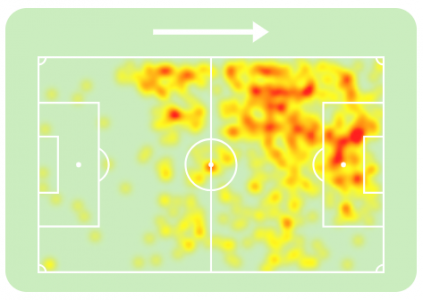Navigation
Install the app
How to install the app on iOS
Follow along with the video below to see how to install our site as a web app on your home screen.
Note: This feature may not be available in some browsers.
More options
Style variation
You are using an out of date browser. It may not display this or other websites correctly.
You should upgrade or use an alternative browser.
You should upgrade or use an alternative browser.
What is our formation?
- Thread starter Bergen Blade
- Start date
All advertisments are hidden for logged in members, why not log in/register?
Frank the tank
Fanny
- Joined
- Apr 2, 2020
- Messages
- 10,909
- Reaction score
- 24,582
he needs to be coming grom deeper hes more a second striker than an out and out centre forwardIt seems that Archer has really benefited from switching to LW. He looks like a different player, much more involved and plays more with a purpose on the ball.
ShockingBadBuy
Often disappointed, never discouraged
It seems that Archer has really benefited from switching to LW. He looks like a different player, much more involved and plays more with a purpose on the ball.
Needs to work on his left foot, though, if he’s going to play on that side, and on cutting inside onto his right—as we saw him do against Everton and Wolves to such great effect.
There were several moments in the last two games where he’s led the break, but then run into a dead end because he doesn’t trust his left foot, hesitates, and the momentum is lost.
He’s looked a real prospect again, in the last couple of games. GLTTL.
HOT CURRIE 10
Active Member
- Joined
- Sep 27, 2016
- Messages
- 1,807
- Reaction score
- 3,039
Good points,he’s a developing young kid who looks the part,I’m sure Wilder and Co have already spotted this along with other players who have improved in little time at all. Basic short instructions given,taken in and then work on their weaknesses. Big test on Saturday.Needs to work on his left foot, though, if he’s going to play on that side, and on cutting inside onto his right—as we saw him do against Everton and Wolves to such great effect.
There were several moments in the last two games where he’s led the break, but then run into a dead end because he doesn’t trust his left foot, hesitates, and the momentum is lost.
He’s looked a real prospect again, in the last couple of games. GLTTL.
Colombia Blade
Member
The same area of the pitch he thrived in for Middlesbrough last season...It seems that Archer has really benefited from switching to LW. He looks like a different player, much more involved and plays more with a purpose on the ball.

Seems to be his 'natural' position as it's also similar to his heat map for his time at Preston.
Champagneblade
Well-Known Member
- Joined
- Jan 24, 2010
- Messages
- 13,988
- Reaction score
- 38,165
He’s a different player to Ndiaye still I feel.he needs to be coming grom deeper hes more a second striker than an out and out centre forward
It feels that Ndiaye picking the ball up deep and using his dribbling helped our play.
Whereas it’s more that Archer’s asset is his raw pace and as the further man up he doesn’t get much of the pitch to explore that, whereas is a role being wide in a three occupying a winger cum striker spot, the space is there for him to get his wings flapping so to speak.
I think Wilder and Knill may well have dropped on there with him in the system. Same with Macca on the other side. It will be interesting how we do with the pair of them alongside McBurnie. Osula is more of a natural athlete but he’s just not there yet in terms of know how and development. So to have a more seasoned 8; perhaps slower player, will be interesting.
loyalblade95
were all blades here pigs not welcome
- Joined
- Aug 4, 2015
- Messages
- 3,766
- Reaction score
- 3,741
4-3-3 against Liverpool.Glad it's working but what is it? 4 3 3 or 4 3 2 1? Hard to work out sometimes.
4-1-4-1 against Brentford.
Probably be 4-1-4-1 against Chelsea this Saturday as it allows us to counter quickly.
Revolution
Well-Known Member
- Joined
- Aug 12, 2009
- Messages
- 13,633
- Reaction score
- 23,139
The interview with Anel on the club podcast prior to Brentford was interesting. Carl Asaba asked him some good questions. Anel said:Formations describe how a team lines up when defending from open play. Certain situations may see the team break out of this general shape, which means it can be difficult to tell what the formation is. For example, when a team is pressing high as the opposition tries to go short from a goal kick. If the team is unsuccessful in winning the ball in said situation, they may seek to reorganising and getting back to the shape we call the formation.
Never mind the shape in which they attack! In modern football there are so many variations in players' roles and movement that a formation is not really fit to describe the team's shape. Full backs often find themselves in more advanced positions than a (holding) midfielder, for example.
So let's see how we lined up in open play; when we did not press high, but dropped deeper as we were looking to defend against Brentford's attack.
4-3-3 (but I fully understand some wanting to call it 4-5-1 or 4-1-4-1 or 4-1-2-2-1...)
Back four.
Midfield, Souza central and most defensively minded. Hamer RCM, Brooks LCM.
Osula central striker. Archer and McAtee wide men, making it a midfield 5 when we were pushed back.
Roles when attacking:
Souza holding. Hamer bit more involved in deep playmaking (17 passes in own half), but also getting forward. Brooks less involved in passing in our half (6), but given licence to take up more advanced positions and bomb forward on the ball more; on occasions popping up in a number 10 position, in front of Hamer and Souza.
Archer and McAtee, cutting inside, supporting Osula, lots of running on the ball.
View attachment 176036
- It was a 4-3-3 to start with v Liverpool, which I think is the general consensus.
- Wilder stressed being on the front foot and more aggressive and, perhaps most crucially, not sitting so deep. I think the absence of Norwood from the team definitely assisted this, given his propensity to hang around next to the centre halves when it isn't going well.
- Anel said that against Liverpool only one player - Archer - was not playing in a position that he had not played before. I wonder whether this was a tacit acknowledgement that some players (Hamer most notably) had not previously been played in their best positions.
There was also an interesting discussion about Anel's perception of the differences between playing in a back 4 and back 5.
On the point generally, it's nice to see Wilder going with in game tactical flexibility.
Similar threads
All advertisments are hidden for logged in members, why not log in/register?
